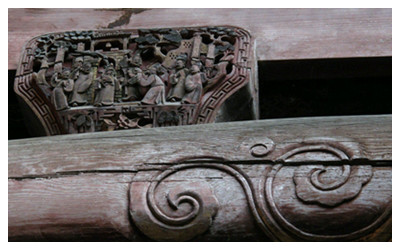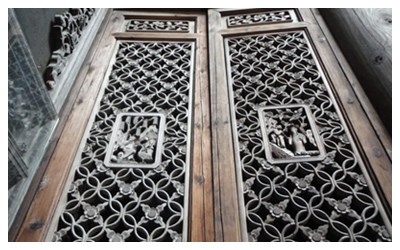Skype: neodalle-travel
Tel: +86 135 7447 2266
E-mail: sales@visitaroundchina.com

 The three most famous caving styles in Huizhou are, brick, stone, and wood carving. The three carvings originated in Song Dynasty and reached their peak in Ming and Qing Dynasty. The carvings are mainly used as decorations for civil residences, ancestral temples, arches and handicrafts like furniture, shelters, pencil vases and etc.
The three most famous caving styles in Huizhou are, brick, stone, and wood carving. The three carvings originated in Song Dynasty and reached their peak in Ming and Qing Dynasty. The carvings are mainly used as decorations for civil residences, ancestral temples, arches and handicrafts like furniture, shelters, pencil vases and etc.Brick carving, done in fine gray bricks of varying shapes and sizes, mainly decorated brick frames and eaves above the gates. The process had two steps: the first step was composing and chiseling an outline in the brick, usually done by a veteran artisan who was familiar with many traditional themes and composition; the second step was carving the relief into the outline, usually done by the apprentices.
With the gray brick being more brittle than ivory, animal bone or wood, but easier to process than the stone, the art of brick carving has a unique style. The exaggeration and distortion of images required by the limited frame they were cut within, and the neat high relief determined by the texture of bricks, help to strengthen the ornamental effect of the work.
The diversified themes of brick carvings can be divided into the following two kinds: historical, and flora and fauna.
 The first kind includes scenes from myths, legends, opera stories, folk customs and so on. Dignitaries in a procession, woodcutters or farmers at work, and shepherd boys on the back of buffaloes are constant images. There are also scenes of people feeding farm animals and fowl, pushing carts, carrying water, and poling boats, as well as scenes of entertainment and performances.
The first kind includes scenes from myths, legends, opera stories, folk customs and so on. Dignitaries in a procession, woodcutters or farmers at work, and shepherd boys on the back of buffaloes are constant images. There are also scenes of people feeding farm animals and fowl, pushing carts, carrying water, and poling boats, as well as scenes of entertainment and performances.
The second kind includes images of animals, birds and flowers. Temples were usually decorated with images of dragons and phoenixes. The southern Anhui artisans were most skilled at carving lions. Following traditional images, they portrayed the lions in various imaginary poses playing with balls and dancing. Each lion was given a personality -- some fierce, some naive, some naughty. More than two lions appearing in one scene are carefully arranged and portrayed so that their poses together form a coherent whole. Other animals like elephants, tigers, dogs, rabbits and monkeys were also common images in brick carving.
Plum blossom, orchid, bamboo, chrysanthemum, pomegranate, orange, tangerine, loquat and lichi were other popular objects for brick carvers. There is a carving of an egret standing beside blossoming and budding lotus flowers -- with images vivid and true to life, the composition discards the traditional symmetry and distortion. This makes the whole work resemble a beautiful painting. These carvings are always framed by symmetrical ancient vessel patterns, eight-treasure patterns and cloud patterns.
Brick carving in the Ming Dynasty was simple and plain, like Han-dynasty stone carvings in tombs. The sculptured main figures and the background in low relief combine without proper perspective. The simple themes, stereotyped figures and symmetric composition make the carving highly decorative. During the last years of the Ming Dynasty and the first years of the Qing Dynasty, brick carving started to show certain influences from the rising of the Xin'an painting school in southern Anhui and the spread of elegant, colorful Anhui-style woodcuts.
During the Qing Dynasty, when the merchants were wealthier, brick carving became more exquisite and complex to suit their magnificent houses. A carving in a brick with a surface less than 0.1 square meter would show several gradations of perspective, with a composition like that of a Chinese painting.
Wood carvings were often found on beams, pillars and their above brackets, upturned eaves, railings, doors, windows and such furniture as cupboards and tables. The application of tung oil instead of colorful paint exposed the natural texture of wood while at the same time protecting the carvings from corrosion.
Stones were used to build the house foundations, memorial archways or bridges, and stone carvings are often seen on roof-beam plates, eaves and socles. The range patterns include Hindu swastika, diamond, plum blossom, bamboo, and dragon.
 Ask Questions ?
Ask Questions ?